Terms curated and defined by Alexandra Kiely, A Scholarly Skater & The Art Museum Insider
My love for Italian art and architecture is undeniable, but also, untrained. Often I have felt guilty at the blessings of being exposed to the beauty of Italian museums and buildings without the knowledge to better appreciate it all.
Thus, I decided to home-school myself in art appreciation, and one of the first sources which I added to my curriculum was Alexandra Kiely’s A Scholarly Skater website, a wealth of knowledge for art history and appreciation. Alexandra is also the founder of the online school The Art Museum Insider), which teaches art appreciation and art history to people of all backgrounds.
“Looking at the art of the past is the closest to time travel I’m likely to get, and it’s much safer,” Alexandra writes. This American art historian has a wonderful way of clearly and concisely presenting information, and I truly feel educated by her work.
In reading her Art Guides and Art Appreciation 101 posts, I was inspired to publish an art glossary here on Prayers and Piazzas. All terms have been curated by Alexandra especially with Italophiles in mind, and are listed here in alphabetical order. If I have added to Alexandra’s definitions, text appears in italic (a font created in Renaissance Florence!)
Art Terms Quick-Start Guide:
Chiaroscuro, contrapposto, fresco, linear perspective, mannerism, maoilica, proto-renaissance, putto, repousse, sfumato, tempura, tenebrism, tondo, triptych, trompe l’Oeil.
Architecture Terms Quick-Start Guide:
Baldacchino, baroque, campanile, lantern, loggia, oculus, relief sculpture.
Onward, art appreciators!
Baldacchino: A baldacchino is a canopy over the altar in a church, sometimes made of a permanent material like bronze. The most famous is Bernini’s baldacchino (below) for St. Peter’s in Rome.
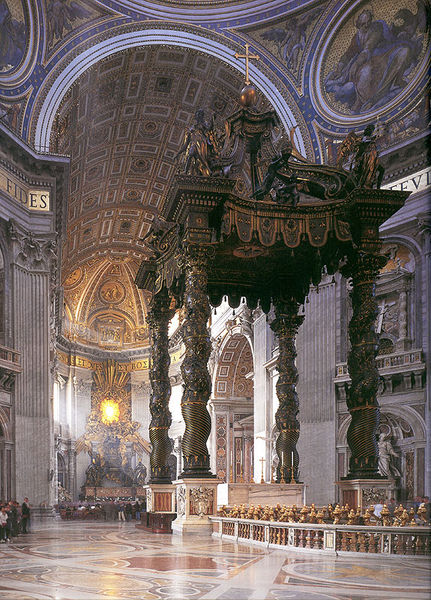
Baroque: This style immediately followed the Renaissance; it was popular in the 17th century. Baroque painting, sculpture, and architecture is often much more elaborate than that of the Renaissance, although the key forms and subjects may be quite similar.
It’s full of drama, theatricality, and artifice. Caravaggio, the Carracci, Gian Lorenzo Bernini, and Francesco Borromini were key players in the Baroque period. The Popes made great use of Baroque architecture in Rome.

Campanile: Italian for bell tower. The Leaning Tower of Pisa is a good example of a campanile, or Giotto’s bell tower in Florence.

Chiaroscuro: A painting technique in which the artist uses light and shadow to give the sense of three-dimensional forms. Caravaggio and El Greco come to mind right away; here’s some other examples from Fra Angelico and Botticelli.
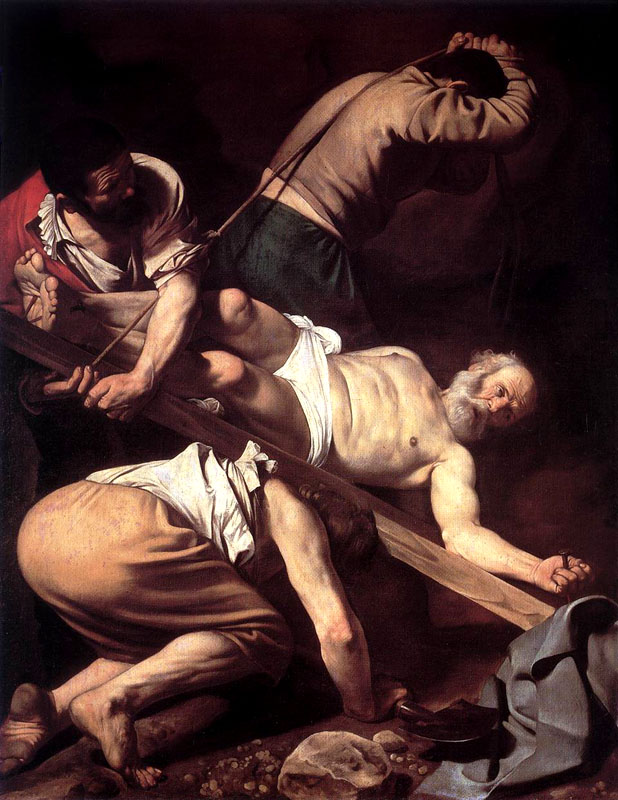
Caravaggio’s Crucifixion of Peter
Contrapposto: Michelangelo’s David provides a clear example of the counterpose, in which all the body’s weight is on one leg, while the other is more relaxed.

Fresco: A technique for painting onto plaster walls. There are two types of fresco painting: Buon fresco involves painting onto wet plaster so that the paint dries into the walls. Fresco secco involves painting onto already-dried plaster and isn’t as durable as buon fresco.

Leonardo’s The Last Supper is not technically a fresco, Michelangelo’s ceiling in the Sistine Chapel (pictured) is.
Lantern: In architecture, a small tower at the top of a dome. It usually has windows.

Linear, One-Point or Scientific Perspective: A method of creating the illusion of three-dimensional space in a two-dimensional work of art. It involves a single (vanishing) point towards which parallel lines in the picture (orthagonals) seem to converge, and it mimics the way the human eye sees three-dimensional space. Filippo Brunelleschi is said to have invented it.
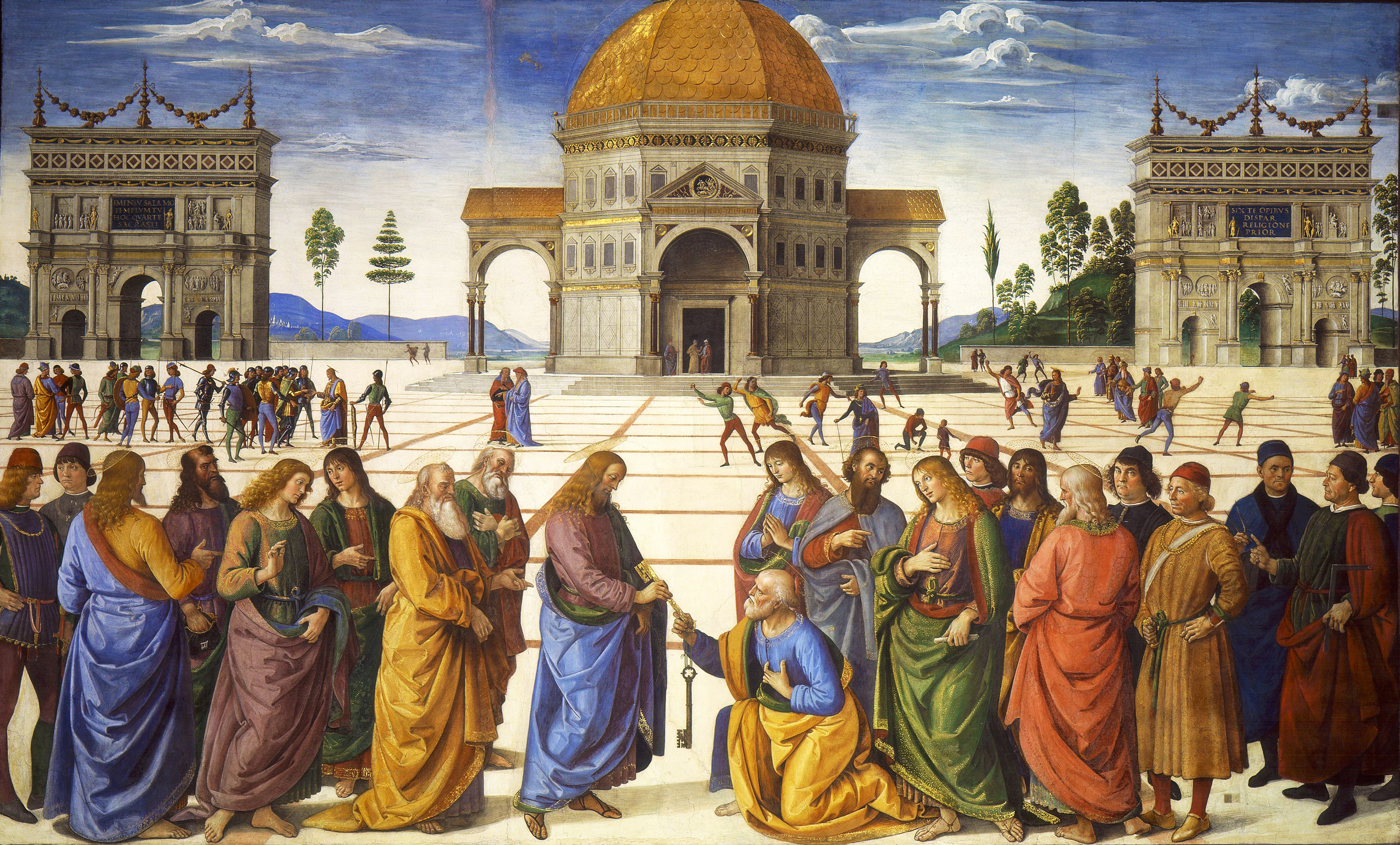
Christ Handing the Keys to Saint Peter by Perugino
Loggia: A covered walkway that is open on one or two long sides. The loggia below, by Giorgio Vasari, is found in his Tuscan hometown of Arezzo.
Mannerism: An artistic movement within the late Renaissance (about 1520-1600). Mannerists exaggerated and distorted shapes, colors, and compositions to create dramatic or disconcerting effects. They often prized artistic skill and creativity over the Renaissance’s devotion to naturalism.

The Italian painter Parmigianino’s Madonna With the Long Neck is a perfect example of a Mannerist work.
Maiolica: A type of earthenware pottery covered with a tin glaze in rich colors. It was popular during the Italian Renaissance.

The term is thought to be derived from Majorca, the island of the same name which was along the medieval shipping route from Spain to Italy. Although not produced in the same way as in the Renaissance, maiolica is still produced in Deruta and Montelupo, Italy.
Oculus: A round window at the top of a dome that allows light into the building.
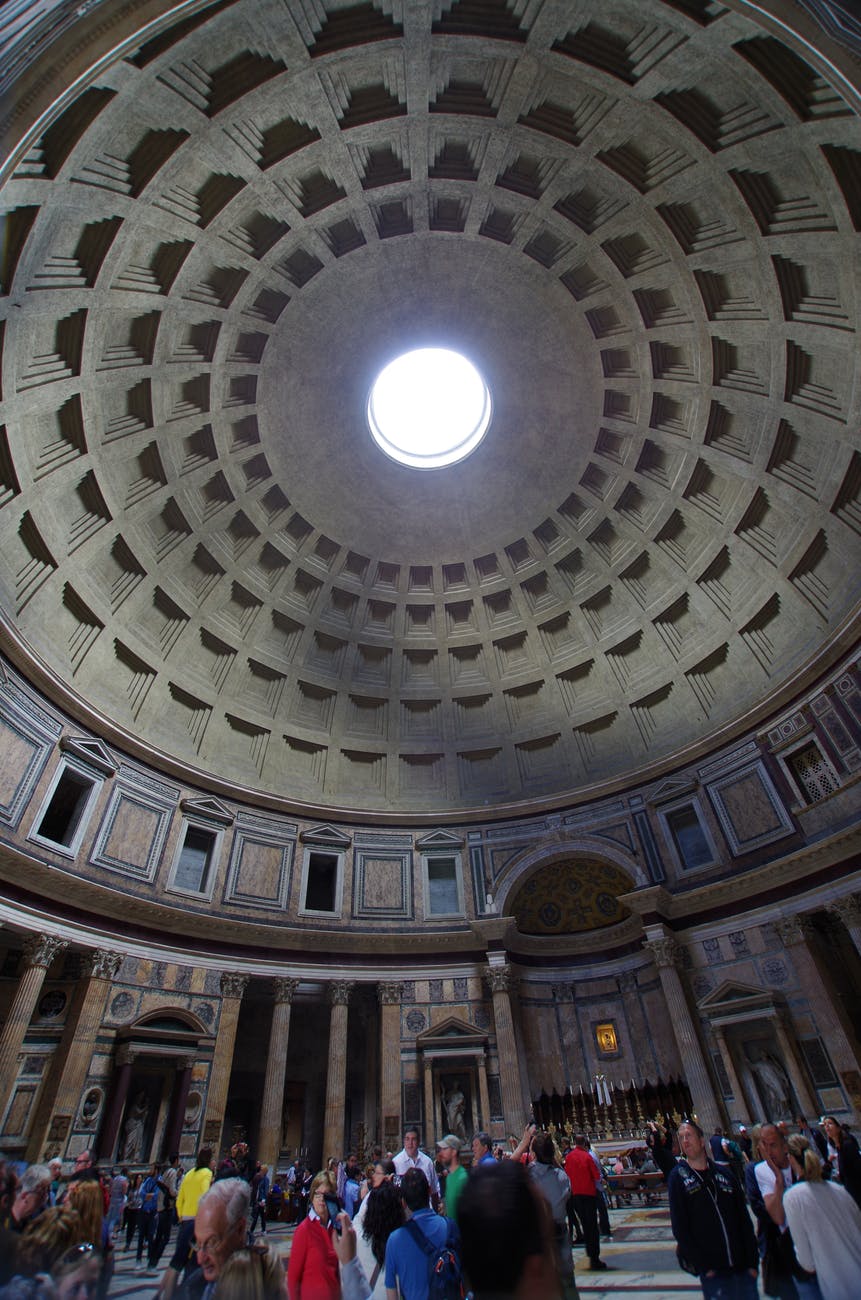
Rome’s Pantheon circa 113-125 AD, image by Pixels
Proto-Renaissance: The Pre-Renaissance, roughly 1200-1400 CE. Italian Proto-Renaissance artists, like Giotto and Duccio began to develop the attributes that would become hallmarks of the Italian Renaissance, usually in religious paintings. They’re sometimes also called the “Italian Primitives”, but this term isn’t used much anymore.

Giotto’s Nativity. Birth of Jesus
Putto (pl. putti): A little figure of a naked baby (usually a boy) with wings, similar to a cupid. Putti often appear in the background of Renaissance artworks.

“Two Putti Reading” by Raphael
Relief sculpture: Sculpture cut into a support (marble, wood, metal, etc.) so that the figures rise up from the background but aren’t fully removed from it. They’re not completely three-dimensional. Relief sculpture is often used in architecture, though it can also be found on its own.

Repousse: A metalworking technique in which the design is hammered from the reverse outward, so it appears in relief.
The Great Dish of Baccus, from Mildenhall Treasure
Sfumato: A smoky atmosphere created through sophisticated use of light and shadow in a painting.
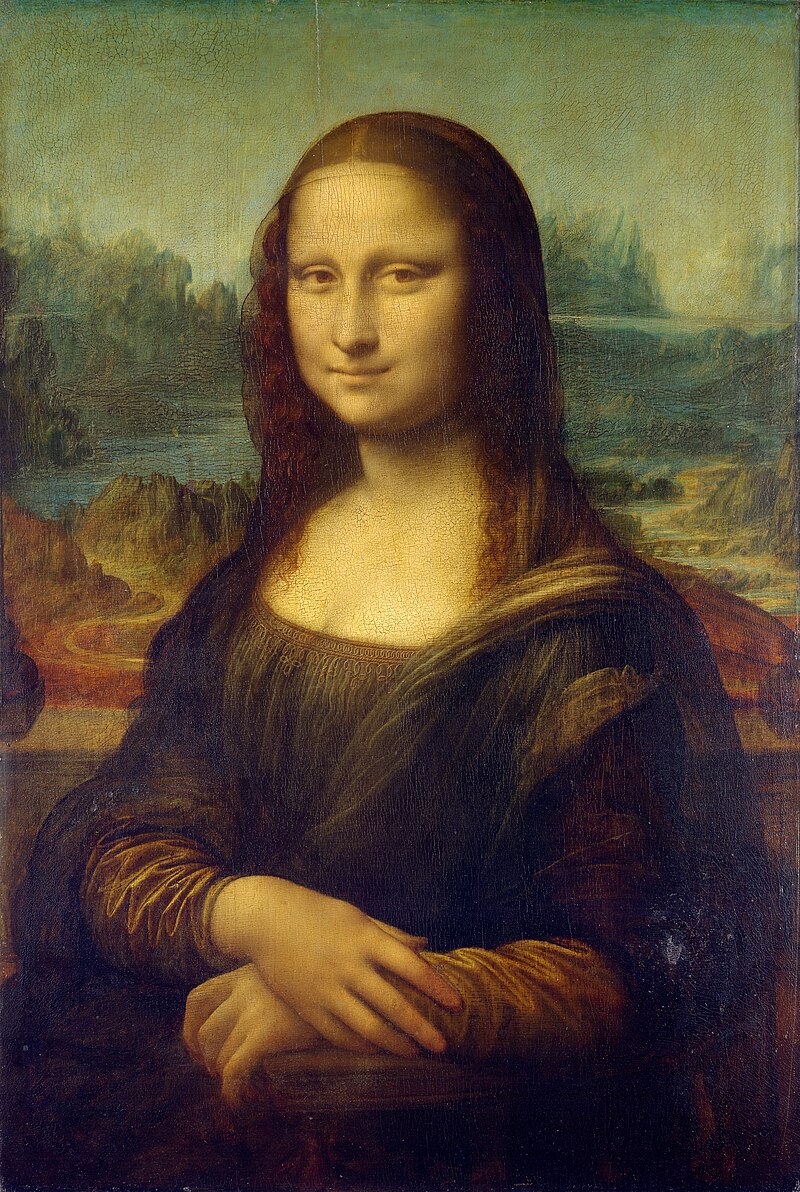
Wikipedia tells us that sfumato is derived from the Italian “fumo”, (smoke, fume), and translated into English it means soft, vague or blurred. Leonardo da Vinci was the king of sfumato. Image Credit
Tempera: A type of paint made with water, pigment, and egg yolk. It was most popular until the introduction of oil paint in the Renaissance. Tempera paint is thicker and more matte in appearance than the glossier oil paint.

Botticelli’s The Birth of Venus
Tenebrism: A painting effect in which a dark composition is highlighted by its most important forms and figures shown in the light – somewhat like a spotlight. Caravaggio was famous for his use of tenebrism.

Caravaggio’s Christ at the Column
Tondo: from the Italian word rotondo — round — a tondo is a circular painting or sculpture.

della Robbia Tondo image credit
Triptych: A painting composed of three separate panels. Altarpieces are often in the form of triptychs, with hinges connection the three parts. An arrangement with two panels is called a diptych, and one with more than three is a polyptych.

This triptych by Giotto is housed at the Vatican Museums.
Trompe l’Oeil: Illusionist painting meant to trick the eye (the literal meaning of the term) into mistaking the flat painted surface for something more three-dimensional.

Alexandra’s A Scholarly Skater is a fantastic resource for people like me, the untrained art lover. Here’s some great places to start: Art Appreciation 101, Art Guides, featuring guides to Renaissance, Greek and Roman architecture, and much more. Alexandra is also the founder of the online school The Art Museum Insider, which teaches art appreciation and art history to people of all backgrounds.
Tante grazie, Alexandra, for sharing your time and expertise here!
Nice work Stacy and Alexandra! A fine reference for art lovers without a background in art studies.
Thank you, so glad you enjoyed it!
Great list Stacy! Most people have no idea how much more they get out of viewing art when they know something about it…until they do. Now i’ll get back to working on my chiaroscuro! Buona Domenica, Cristina
Good luck on your work, and grazie, so glad you enjoyed it!
Wonderful blog! I’ve loved Italian art forever, but never really knew these terms. And your photos are a beautiful accompaniment.
Thank you, so glad you liked it!
Thank you for defining the above terminology Stacy. There were many words I had heard of but never knew their meanings!
I’m so glad you enjoyed it, thank you!
Mille grazie for asking me to write this! I’m happy and honored that you enjoy my work. I hope everybody who reads this learns a lot and then has fun going out to see great art!
Grazie a te for putting together a very informative glossary! Keep up your great work!